New Frontier Implosion

Viewing video requires the latest version of Adobe's Flash Player
New Frontier Implosion
Opened: Oct, 30, 1942
Closed: July 16, 2007
Imploded: Nov. 13, 2007
When the New Frontier met its final demise in 2007, it was one of the few remaining Strip hotels to have witnessed the transformation of a portion of Highway 91 into one of the most famous streets in the world.
When the casino opened in the 1930s as the Pair O' Dice casino, built by British theater owner R.E. Griffith, it was only the second property on what is today known as the Las Vegas Strip. It underwent several transformations and passed through the hands of many owners. One of Las Vegas' major developers, Steve Wynn, even had a small stake in the operation when he first started out in the city.
In 1942, it was remodeled into the Western-themed Last Frontier, and became one of the Strip's first themed casinos. It was renamed once again in April of 1955 as the New Frontier, after a renovation modernized the resort. Billionaire Howard Hughes purchased the property for about $14 million in 1967 and the western theme was dropped, along with part of its name, and it emerged as simply The Frontier. In 1999, after a few more changes in ownership, the name was changed back to the New Frontier.
As the era of the megaresorts ushered in an evolution of the Strip, the New Frontier took on a different role. It was sought out not as a Las Vegas destination but as a hotel that offered cheap room rates near the newer attractions. Its glory days as a classy establishment that hosted Elvis Presley's first Las Vegas performance, as well as the final performance of Diana Ross and the Supremes, were quickly forgotten. It became a place known mainly for its mechanical bull, often ridden by bikini clad women, inside the Gilley's cowboy bar.
The 16-story New Frontier was imploded just after 2:30 a.m. on Nov. 13, 2007.
Stardust Implosion
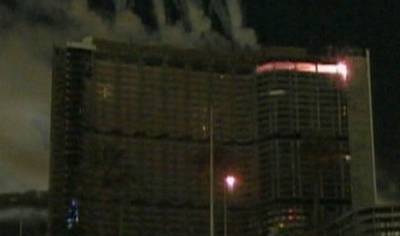
Viewing video requires the latest version of Adobe's Flash Player
Stardust Implosion
Opened: July 2, 1958
Closed: Nov. 1, 2006
Imploded: March 13, 2007
The opening of the Stardust, themed after the stars and planets, proved to be one of a kind.
In 1958, the Stardust was the largest casino in Nevada and the largest hotel in the world, holding approximately 1,000 rooms.
When Howard Hughes moved to purchase the hotel in the 1960s, along with many other Strip casinos, the U.S. government blocked the deal, fearing that a monopoly was taking shape. Instead, Delbert Coleman purchased the hotel and later sold it to Argent Corp.
In the 1970s, members of the Stardust management were implicated in skimming cash from the casino's cage in a Nevada Gaming Commission investigation. The operation was believed to have been run by mobster Franky "Lefty" Rosenthal during the 1970s and '80s, setting the background for the film "Casino." The mob reign behind the Stardust came to an end in 1983 when federal agents conducted a raid on the property. Rosenthal was banned from Nevada casinos for life.
The casino's next owners, Las Vegas businessman Al Sach and Herd Tobman, were suspected of the same operation after acquiring the casino. They too were removed as owners and fined $3.2 million, a new state record.
In the pursuit of a reputable owner, the Stardust was sold to Boyd Gaming in 1985.
The Stardust premiered Lido de Paris, one of the first shows in Las Vegas to feature topless dancers. Entertainers Siegfried and Roy also appeared in the show.
Boyd closed down the Stardust to construct the $4 billion Echelon Place, expected to open in 2010. The 32-story Stardust was imploded on March 13, 2007, with 428 pounds of dynamite.
Boardwalk Implosion
Opened: 1968
Closed: Jan. 9, 2006
Imploded: May 9, 2006
The Boardwalk Casino — modeled after Coney Island, with a replica of the parachute drop and facsimile wooden roller coaster on the roof — opened as a branch of the Holiday Inn hotel chain. Many tourists, not knowing the ride was fake, would come into the casino and request a spin.
The casino was purchased by Boardwalk Casino Inc. in 1994, which added a 16-story tower in 1996. MGM purchased the Boardwalk in 2000 and the casino was closed and imploded in 2006 to prepare for MGM's project City Center, a $7 billion resort and entertainment complex featuring high-rise condominiums and upscale hotels.
Desert Inn Implosion
Opened: April 24, 1950
Closed: Aug. 28, 2000
Imploded: Oct. 23, 2001
Originally it was called Wilbur Clark's Desert Inn, after the owner, a San Diego gambler and developer. When construction funds ran out in 1948, Clark traded away 74 percent interest in the property to the Cleveland mob, led by Moe Dalitz. Although Clark remained as figurehead, Dalitz and his partners were in control.
On Thanksgiving day, 1966, Howard Hughes rented out the top two floors with an agreement to stay for 10 days. After overstaying his welcome by several months he was asked to leave. Instead, Hughes purchased the Desert Inn from Dalitz on March 1, 1967, for about $14 million. The hotel soon expanded by adding the 14-floor Augusta Tower, at a $54 million price tag.
In 1997, after passing through several owners including Kirk Kirkorian and ITT/Sheraton, the hotel went through a $200 million upgrade. The renovation actually reduced the resort's 821 rooms to 715 in order to provide extra accommodations. An additional tower and lagoon-stye pool where also added.
On April 24, 2000, the Desert Inn turned 50 years old and buried a time capsule to be opened April 25, 2050, a day after the Desert Inn turns 100.
Three days after its birthday on April 27, 2000, Steve Wynn purchased the Desert Inn for $275 million. He closed it several months later and imploded it's towers between 2001 and 2004. The Wynn Las Vegas now stands in its place.
El Rancho Implosion
Opened:1948
Closed:1992
Imploded: Oct. 3, 2000
Originally the Thunderbird (1948-1976), then the Silverbird (1976-1981), the El Rancho took shape after Ed Torres purchased the property in 1981 for $500,000. He sought to honor the property with the name of one of the Strip's first resorts (The original El Rancho Vegas was located just across Las Vegas Boulevard).
The next year Torres hired Martin Stern Jr. to expand the hotel, adding a tower and a new entrance. Stern would again expand and remodel the hotel and casino in 1987 but the changes did little to help the casino's success.
The struggling property was closed in 1992 and sold to a New Jersey company. The company was unable to get financing in order to reopen the casino and was ordered by the city to tear the building down in 1999.
In 2000, the property was sold to Turnberry Associates and imploded with 700 pounds of explosives on Oct. 3, 2000 in front of a crowd of 2,000 spectators.
The area is now occupied by the Turnberry Towers condominiums and the Fountainebleau Resort construction site.
Aladdin Implosion
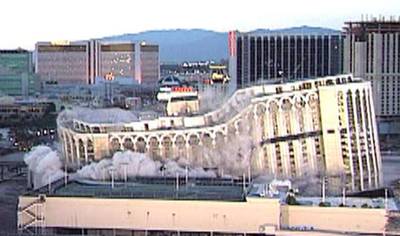
Viewing video requires the latest version of Adobe's Flash Player
Aladdin Implosion
Opened: April 1, 1966
Closed: Nov. 25, 1997
Imploded: April 27, 1998
Reopened: Aug. 17, 2000
The resort's first iteration, the Tally-Ho, gave way to the King's Crown in 1964, but because the gaming license was denied, King's Crown failed within six months.
Purchased and renovated for $3 million, new owner Milton Prell gave the property an Arabian theme and renamed it the Aladdin. When the Aladdin first opened its doors in 1966, entering guests were showered with flower petals.
The Aladdin became world-famous for hosting the wedding of entertainer Elvis Presley to Priscilla Anne Beaulieu.
Parvin Dohrmann took over the Aladdin, after Prell had a stroke, only to sell it in 1972 for $5 million. The owners, Sam Diamond, Peter Webbe, Sorkis Webbe and Richard Daly, began a $60 million renovation project including a 19-story tower.
Las Vegas entertainer Wayne Newton was a part owner of the Aladdin along with Ed Torres, who later bought Newton's shares, from 1980 until 1982.
After several more ownership changes, the old Aladdin closed in 1996 and was imploded in 1998.
A brand new $1.4 billion mega-resort opened on the site in 2000, keeping the name Aladdin. Eventually the new Aladdin also experienced financial woes and was purchased by Planet Hollywood and Starwood Hotel & Resort Worldwide for $637 million in 2003.
It officially reopened the next day being greeted by workers, including members of the Culinary Local 226, protesting the Aladdin not opening with a union contract. The Aladdin financial problems landed the property in bankruptcy.
The hotel went through another renovation and was reopened April 17, 2007, as Planet Hollywood Casino and Resort.
Hacienda Implosion
Opened: June 1957
Closed:1996
Imploded: Dec. 31, 1996
Built on 48 acres, the Hacienda had 10 buildings and started out with 240 rooms. It was remodeled in 1975 and later expanded in the early 1990s to 1,140 rooms in order to compete with the booming mega-resorts nearby. During its first couple of years the casino remained closed due to problems acquiring a gaming license.
Only two miles from McCarran International Airport, and for most of its years the first hotel on the highway from Southern California, it attracted an ample amount of tourists but remained somewhat solitary until the 1970s.
The Hacienda was known for family entertainment and featured miniature golf. Warren "Doc" Bailey, hotel owner, wanted to have something that kept children occupied while their parents gambled. In 1960, Bailey purchased eight small passenger airplanes for $2 million in order to to provide customers with a package deal that would include airfare and hotel stay. In the 1970s and 1980s, tourist traffic grew for the Hacienda, due in large part to it's location at the southern end of the Strip.
In its heyday, the Hacienda showroom launched the career of Monte Carlo headliner Lance Burton, and featured long-time comedian Redd Foxx. Even with star attractions and a family-oriented environment, the Hacienda could not compete with the flashy resorts that grabbed tourist attention. The hotel was imploded on New Year's Eve of 1997 to make way for Mandalay Bay.
The neon horse and rider from the old Hacienda sign now decorates the intersection of Fremont Street and Las Vegas Boulevard in downtown Las Vegas.
Sands Implosion
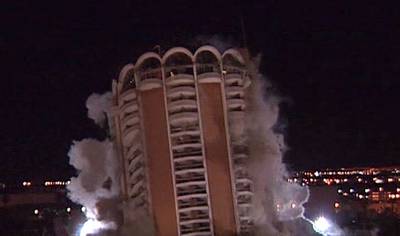
Viewing video requires the latest version of Adobe's Flash Player
Sands Implosion
Opened: Dec. 15, 1952
Closed: June 30, 1996
Imploded: Nov. 26, 1996
The seventh resort on the Strip, known as the Sands, opened to tourists on Dec. 15, 1952. It was designed by architect Wayne McAllister.
The Sands opened with only a few hundred rooms. Through the years, it passed through the hands of several Las Vegas land tycoons, including Howard Hughes, who purchased it in the mid 1960s. Hughes added an iconic 500-room circular tower designed by popular hotel architect, Martin Stern Jr.
Other owners included Kirk Kerkorian, who purchased it in 1988, and, in 1989, the Interface Group, which included Sheldon Adelson.
The original "Oceans 11" movie was filmed at the Sands in 1960. The film, including Frank Sinatra, Dean Martin, Sammy Davis Jr., Joey Bishop and Peter Lawford, inspired a meeting, known as the Summit at the Sands, and united the stars, known worldwide as the Rat Pack.
Along with "Oceans 11", the Sands was featured in "Con Air" and "The Cooler". In 1996, Adelson closed the famous resort down and imploded the Sands to make way for the Venetian.
Landmark Implosion
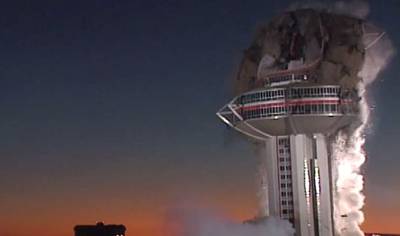
Viewing video requires the latest version of Adobe's Flash Player
Landmark Implosion
Opened: July 1, 1969
Closed: Aug. 8, 1990
Imploded: Nov. 7, 1995
In 1961, Frank Carroll purchased a vacant lot of land on the corner of Paradise Road and Convention Center Drive with the hope of building the Landmark hotel and casino. Carroll's dream would not be completed until 1969, after a long series of mishaps.
Carroll began construction when he received a $300,000 loan from a credit union. He hired California contractors to oversee the original 15-story project, and later doubled the size to 31-stories. The tower was 365 feet tall. In 1962, after a denial of additional funds from the credit union, construction stopped and the the building sat empty, only 80 percent complete.
Construction resumed in 1966 after a four-year hiatus when Carroll received additional funding. Another $5.5 million was loaned to him by the Teamsters Union Pension Fund. The tower was to be completed in 1967 and opened on New Year's Eve of that year. However, Carroll once again ran out of money.
He pushed back opening date until Howard Hughes purchased the Landmark in January 1969 and agreed to pay off Carroll's loans. The hotel opened July 1, 1969, but couldn't break out of its financial hole.
In 1970, when Hughes left Las Vegas, control of the Landmark passed to Summa Corp., resulting in a $5.9 million loss in profit.
The Landmark passed from owner to owner suffering further financial loss. Still, it was featured in hit movies, such as "Casino" and "Diamonds are Forever," and hosted famous entertainers, including Frank Sinatra and Elvis Presley. But many knew that it was only a matter of time before the Landmark would be removed from the Las Vegas skyline.
After the start of the mega-resorts era of Las Vegas, the Landmark became too expensive to keep open and it closed its doors on Aug. 8, 1990.
The future of the Landmark, which remained vacant for many years, was debated over by the Las Vegas Convention and Visitors Authority in 1994. Some wanted to restore the casino and others wanted to demolish it. Those in favor of demolition won. The Landmark was imploded Nov. 7, 1995. Footage of the implosion used in the film, "Mars Attacks." The property which housed the Landmark ended the way it began, as a vacant lot. The property now houses overflow parking for the Convention Center.
Dunes Implosion
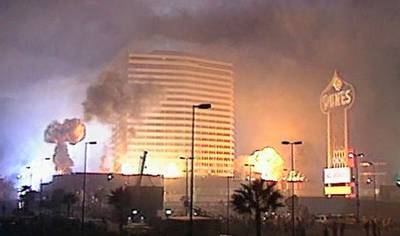
Viewing video requires the latest version of Adobe's Flash Player
Dunes Implosion
Opened: May 23, 1955
Closed: Jan. 26, 1993
Imploded: Oct. 27, 1993
With the slogan "The Miracle in the Desert," the Dunes hotel offered a desert oasis theme and featured a 35-foot-tall fiberglass sultan on its roof. The walls inside the Dunes were slanted, mirroring desert tents.
Through the years, the Dunes continued to add "Arabian Nights" themed elements including an onion-shaped dome. The hotel eventually added performers like Aztec Birdman, who performed ritual dances, and flying Indians to perform by the pool.
In 1961, the Dunes added the Diamond of the Dunes, a tower which was the largest in the state, bring the total number of rooms available to 400. In 1976, another 17-story tower was added, which brought the number of rooms offered to 1,300.
The Dunes hosted entertainers such as Frank Sinatra and offered the first topless revues on the strip, known as Minsky's Follies.
In 1987, Japanese millionaire Masao Nangaku purchased the resort for $155 million. Nangaku could not make the Dunes successful and in 1993, sold it to Steve Wynn's Mirage Resorts Inc. for only $75 million. It was ceremoniously imploded on Oct. 27, 1993, starting an implosion trend in Las Vegas that continues to this day. The Bellagio now occupies the former Dunes property.
— Sun interns Rob Ponte and Michael Lyle compiled this report.

